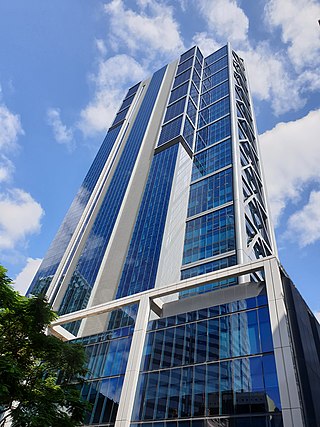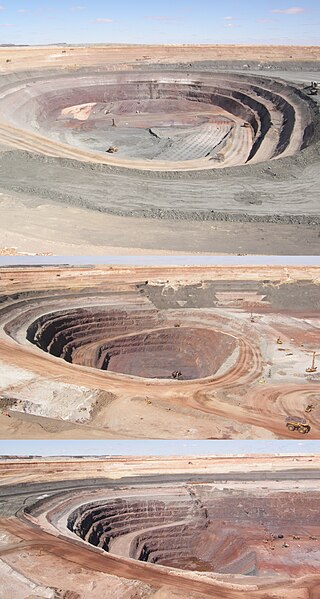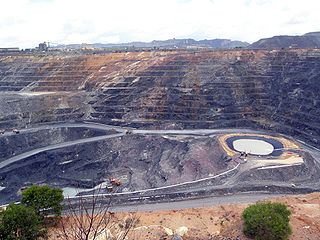
BHP Group Limited, also known as Broken Hill Proprietary Company and formerly as BHP Billiton is an Australian multinational mining and metals public company that was founded in August 1885 and is headquartered in Melbourne.

Mining in Australia has long been a significant primary sector industry and contributor to the Australian economy by providing export income, royalty payments and employment. Historically, mining booms have also encouraged population growth via immigration to Australia, particularly the gold rushes of the 1850s. Many different ores, gems and minerals have been mined in the past and a wide variety are still mined throughout the country.
The Australian Uranium Association was an Australian industry trade group which represented companies involved in uranium exploration, mining and export. It operated from September 2006 until 2013, after which its responsibilities were absorbed by the Minerals Council of Australia.

Port Bonython is the location of a deepwater port, gas fractionation plant and diesel storage facility west of Point Lowly in the Upper Spencer Gulf region of South Australia. It lies 16 km east-northeast of Whyalla, South Australia and approximately 370 km north-west of the State's capital city, Adelaide. The existing wharf is 2.4 kilometres long and is capable of berthing small Capesize ships with a maximum capacity of 110,000 tonnes. The wharf was established in 1982 and named after John Bonython, the founding chairman of Santos. The structure is leased to Santos by the Government of South Australia and is used for the export of hydrocarbon products. An oil spill at Port Bonython in 1992 resulted in loss of bird life and damage to mangrove habitats to the west and southwest of Port Pirie.

OZ Minerals is a mining company based in Adelaide, South Australia. Formerly listed on the Australian Securities Exchange, it was acquired by BHP in April 2023.

The Prominent Hill Mine is a major copper, silver, and gold mine in north west South Australia, 130 km south-east of Coober Pedy, which was developed by Oxiana Limited, later to become OZ Minerals, and now owned by BHP. The deposit is an iron oxide copper gold style mineralisation.

Radioactive ores were first extracted in South Australia at Radium Hill in 1906 and Mount Painter in 1911. 2,000 tons of ore were treated to recover radium for medical use. Several hundred kilograms of uranium were also produced for use in ceramic glazes.

Iron ore mining in Western Australia, in the 2018–19 financial year, accounted for 54 percent of the total value of the state's resource production, with a value of A$78.2 billion. The overall value of the minerals and petroleum industry in Western Australia was A$145 billion in 2018–19, a 26 percent increase on the previous financial year.
Eric Roger Goldsworthy AO is a former Australian politician and 3rd Deputy Premier of South Australia from 1979 to 1982. Goldsworthy represented the House of Assembly seat of Kavel for the Liberal and Country League and Liberal Party from 1970 to 1992. Before entering Parliament he was a farmer and teacher. He was also a member of University of Adelaide Council 1970–1973. He became deputy leader of the SA Liberals, and hence Deputy Leader of the Opposition, in 1975 when David Tonkin successfully challenged Bruce Eastick's leadership. As such, he became Deputy Premier when the Liberals won the 1979 state election, also serving as Minister of Mines and Energy, Services and Supply. He remained deputy leader when the Liberals went back into opposition in 1982 under John Olsen, and held the deputy's post until returning to the backbench in 1989.
The Iron Valley mine is a small iron ore mine located in the Pilbara region of Western Australia, 75 kilometres (47 mi) northwest of Newman, 270 kilometres (170 mi) south of Port Hedland, and 10 kilometres (6 mi) east of the Yandicoogina mine.

The Olympic Dam mine is a large poly-metallic underground mine located in South Australia, 550 km (340 mi) NNW of Adelaide. It is the fourth largest copper deposit and the largest known single deposit of uranium in the world. Copper is the largest contributor to total revenue, accounting for approximately 70% of the mine's revenue, with the remaining 25% from uranium, and around 5% from silver and gold. BHP has owned and operated the mine since 2005. The mine was previously owned by Western Mining Corporation. Since the 1970s environmentalists, traditional owners and others have campaigned against the mine, largely on the basis of its contribution to the nuclear cycle and its use of underground water.
The Resources Industry Development Board (RIDB) was formed in 2000 to enhance the growth of the state of South Australia's mineral and petroleum resources sector and its contribution to the state's economy. It was formed in response to recommendations of the Resources Task Force made the previous year. The RIDB provided advice to the Minister for Mineral Resources and Energy and the state government. There was a high degree of inter-activity with the Primary Industries and Regions SA (PIRSA) Division of Minerals and Energy which also provided the Board's secretariat.
The Resources and Energy Sector Infrastructure Council (RESIC) was created by the State Government of South Australia in 2007 to support the development of future infrastructure projects. It was a small group of senior executives selected to represent the industry and public sector's leaders. The council facilitates close working relationships between private and public sectors on infrastructure planning and development matters and aims to foster cooperation between companies to maximize the value of proposed infrastructure and minimize unnecessary duplication.
The Institute for Mineral & Energy Resources (IMER) is the point of contact at the University of Adelaide for strategic research interests related to mineral and energy resources. It was founded in 2009 and launched h Australian Minister for Mineral Resource Development, Paul Holloway on 5 October 2010. The institute attracted over $18.5 million in research funding and corporate sponsorship in its first year. The IMER facilitates collaborative research between the higher education sector and industry and can take the shape of project collaboration to meet a company's specific needs, consultancy utilising academic researchers and PhD students, organisational collaboration to leverage government funding and long-term partnerships offering mutual benefits.
UCL Australia was an international campus of the University College London, located on Victoria Square in Adelaide, South Australia. It had three parts: the School of Energy and Resources (SERAus), the International Energy Policy Institute (IEPI) and a branch of UCL's Mullard Space Science Laboratory. UCL Australia described its university community as "welcoming, dynamic and influential." The campus closed in December 2017.
Benjamin "Ben" Heard is a South Australian environmental consultant and an advocate for nuclear power in Australia, through his directorship of environmental NGO, Bright New World.

Kyra Reznikov is a South Australian commercial lawyer and Special Counsel at legal firm Finlaysons.
Gordon Toll is a career mining industry professional and company director, with long term interests in iron ore mining and magnetite project development. In 2020 he was appointed non-executive director of Free Eyre Ltd and its subsidiary Peninsula Ports Pty Ltd, with the expectation of the company realising the Port Spencer project in South Australia ahead of the summer of 2020-21.
Terry Burgess is a resources sector businessman and industry representative based in South Australia, best known for his roles as former CEO of the Australian Securities Exchange-listed copper mining company Oz Minerals (2009-2014) and former president of the South Australian Chamber of Mines & Energy (SACOME).









